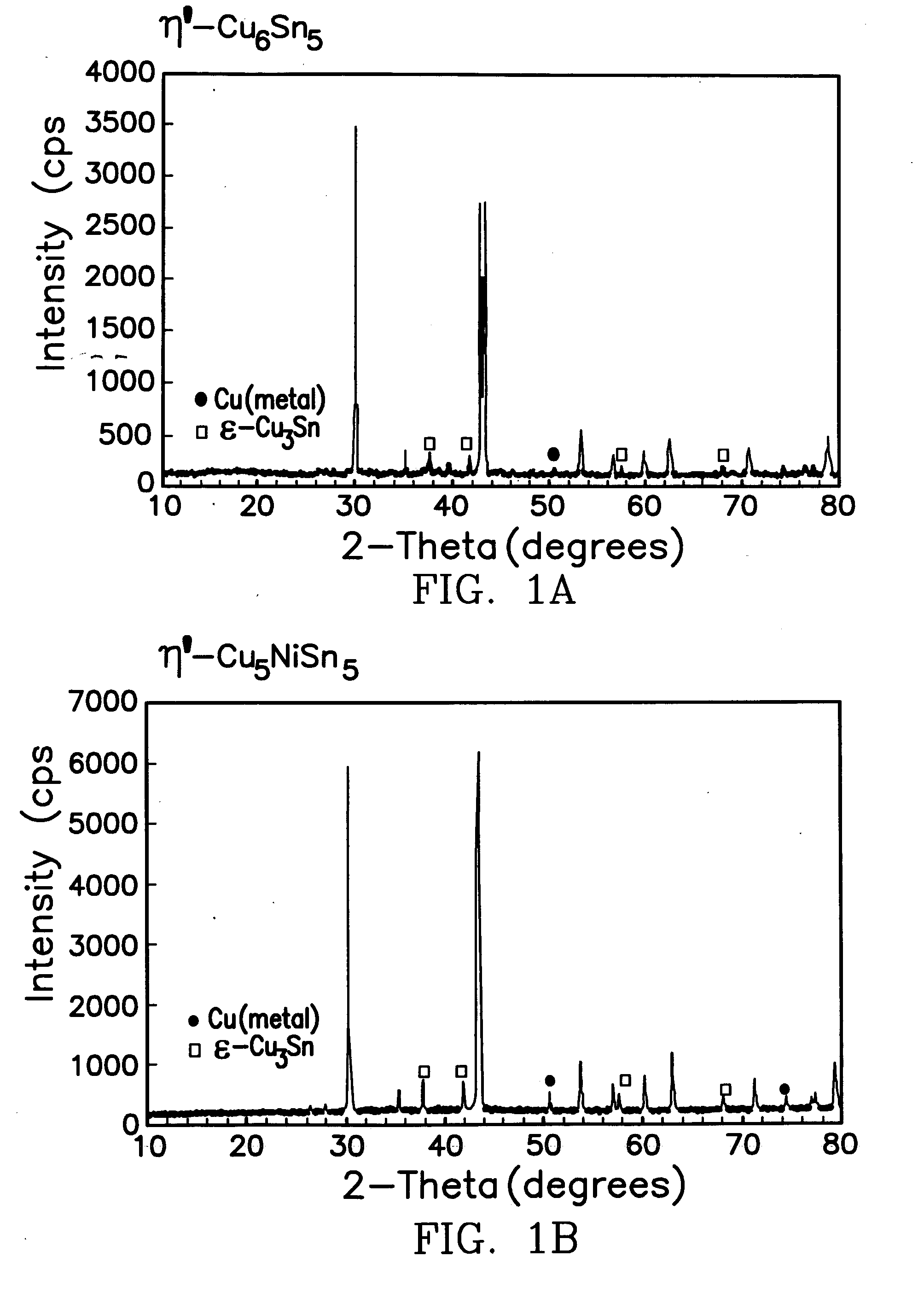Synthesis of intermetallic negative electrodes for lithium cells and batteries
- Summary
- Abstract
- Description
- Claims
- Application Information
AI Technical Summary
Benefits of technology
Problems solved by technology
Method used
Image
Examples
example 1
[0025] For the synthesis of Cu6Sn5, Cu5NiSn5, Cu5FeSn5, InSb and Cu2Sb, stoichiometric amounts of the metal chloride salts totaling 1 gram were dissolved in 10 ml ethylene glycol, stirred for 3 h at 0° C. during the addition of zinc metal powder, and then stirred at room temperature for another 16 hours. The solid products were isolated by vacuum filtration, rinsed and washed with methanol to remove the soluble by-product, ZnCl2. The products were dried at room temperature under vacuum. The Cu6Sn5, Cu5NiSn5, Cu5FeSn5, InSb powders were annealed under argon gas at 400° C., whereas the Cu2Sb powder was used, as is, after vacuum drying at room-temperature. The X-ray diffraction patterns (CuKa radiation) of the five intermetallic products, namely, Cu6Sn5, Cu5NiSn5, Cu5FeSn5, InSb and Cu2Sb are shown in FIG. 1 (a-e). As can be seen from the figures, the X-ray diffraction patterns of the Cu6-xMxSn5 products show minor concentrations of Cu3Sn and Cu by-products, while the InSb sample shows...
example 2
[0026] The electrochemical properties of the intermetallic Cu6Sn5, Cu5NiSn5, Cu5FeSn5, InSb and Cu2Sb products were evaluated as electrodes in lithium cells having the following configuration Li / EC:DEC (1:1), 1 M LiPF6 / intermetallic electrode. Each electrode consisted of 84% intermetallic compound, 8% carbon, 8% PVDF binder. Cells were charged and discharged at constant current at 0.2 mA / cm2. The data in FIGS. 2 and 3 show the electrochemical performance of the electrodes when synthesized by the method of this invention; the voltage profiles of the various cells in FIG. 2 are consistent with those of Cu6Sn5, Cu5NiSn5, Cu5FeSn5, InSb and Cu2Sb electrodes when synthesized by high-energy ball-milling techniques.
[0027] This invention extends to include non-aqueous electrochemical lithium cells and batteries containing such intermetallic electrodes when synthesized according to the said method. A representation of such a cell is shown schematically in FIG. 4, the cell represented by the...
PUM
| Property | Measurement | Unit |
|---|---|---|
| Temperature | aaaaa | aaaaa |
| Temperature | aaaaa | aaaaa |
| Time | aaaaa | aaaaa |
Abstract
Description
Claims
Application Information
 Login to View More
Login to View More - R&D
- Intellectual Property
- Life Sciences
- Materials
- Tech Scout
- Unparalleled Data Quality
- Higher Quality Content
- 60% Fewer Hallucinations
Browse by: Latest US Patents, China's latest patents, Technical Efficacy Thesaurus, Application Domain, Technology Topic, Popular Technical Reports.
© 2025 PatSnap. All rights reserved.Legal|Privacy policy|Modern Slavery Act Transparency Statement|Sitemap|About US| Contact US: help@patsnap.com



